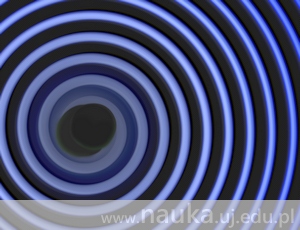
Nobel Prize-worthy, major breakthrough, historic discovery – these are just some of the words the scientific world used to describe the announcement confirming the existence of gravitational waves. In the article below, Dr Sebastian Szybka from the JU Astronomical Observatory explains this phenomenon.
1Question is a series of articles by the University Marketing science communication unit, in which specialists and experts from various fields briefly discuss interesting issues related to the world, civilisation, culture, biology, history, and many more.
One hundred years ago, Albert Einstein first published his general relativity theory. According to the theory, space and time form an integral whole called space-time. Gravity is nothing more than curving of the space-time's geometry due to its accumulated energy. After Einstein formulated his field equations, he noticed that disturbances in space-time may propagate even if no matter is present. This works similar to how waves form on water after a stone is dropped into it. These expanding "wrinkles" on space-time are gravitational waves.
Astronomical observations of binary neutron stars PSR B1913+16 indirectly confirm the existence of gravitational waves. Despite half a century's worth of efforts, scientists have not been able to prove it. But that changed recently. During a press conference organised on 11 February 2016, representatives of the LIGO project (Laser Interferometer Gravitational-Wave Observatory) informed the public about the first direct observation of gravitational waves. It was accomplished with two ground interferometers located in the USA. By monitoring the distance between two mirrors using a laser beam, we can measure the disturbances of space-time caused by gravitational waves. The effect is minuscule far away from its origin point.
 On 14 September 2015 at 9:50:45 UTC, after travelling 1.3 billion light years, a gravitational wave reached the LIGO Livingston detector. 6.9 milliseconds later, space-time oscillation was observed in the LIGO Hanford detector, located about 3000 kilometres away. Although the amplitude of these vibrations was very small (a thousandth of a proton, i.e. 10-18m), it was possible to infer the location of their source from their trajectory. In a distant galaxy, two black holes (with masses 36 and 29 times bigger than the Sun, respectively) collided with each other, creating an even black hole with a mass 62 times bigger than the Sun. During the collision, 3 Sun's masses worth of energy was produced and radiated out in the for of gravitational waves. Though these two black holes are specks of dust on the cosmic scale (the larges black holes exceed the Sun's mass by several billion times), the energy emitted at the peak of the event was 50 times higher than that of all the stars in the observable universe.
On 14 September 2015 at 9:50:45 UTC, after travelling 1.3 billion light years, a gravitational wave reached the LIGO Livingston detector. 6.9 milliseconds later, space-time oscillation was observed in the LIGO Hanford detector, located about 3000 kilometres away. Although the amplitude of these vibrations was very small (a thousandth of a proton, i.e. 10-18m), it was possible to infer the location of their source from their trajectory. In a distant galaxy, two black holes (with masses 36 and 29 times bigger than the Sun, respectively) collided with each other, creating an even black hole with a mass 62 times bigger than the Sun. During the collision, 3 Sun's masses worth of energy was produced and radiated out in the for of gravitational waves. Though these two black holes are specks of dust on the cosmic scale (the larges black holes exceed the Sun's mass by several billion times), the energy emitted at the peak of the event was 50 times higher than that of all the stars in the observable universe.
Polish scientists have also contributed to the LIGO discovery. the LIGO team closely collaborates with the research team of the European Virgo interferometer. A Polish group, Virgo-POLGRAW, led by Prof. Andrzej Królak from the Institute of Mathematics of the Polish Academy of Sciences, is working within the framework of the Virgo consortium. They are tasked with data analysis, theoretical research of gravitational waves emitted by astrophysical objects as well as preparing algorithms for searching these waves. They were also involved in the construction of the Virgo interferometer in Italy. Since last year, research groups led by Prof. Michał Ostrowski from the JU Astronomical Observatory and Dr hab. Andrzej Kułak from the Chair in Electronics of the AGH University of Science and Technology analyse the impact of extremely low frequency gravitational waves (naturally occurring on Earth) impact on the Virgo and LIGO detectors.
The concepts of gravitational waves and black holes were arduously developed over decades, based on Einstein's theory of gravity. Einstein himself stopped believing in them after he made a mistake. Detecting gravitational waves would not be possible without several generations of physicists. They are researched at the Jagiellonian University as well: in the Department of Relative Astrophysics and Cosmology, and the Department of Relativity Theory and Astrophysics.
Although the waves detected by LIGO are very weak, they are shaped by extremely violent processes occurring billions of light years away from Earth. The LIGO research team confirmed that these processes are governed by rules explained in Einstein's equations. It would be tempting to say that this achievement is the crown jewel of a hundred years' worth of work. It is so, but it just the beginning, not the end.
Almost all information about space that we have we discovered via electromagnetic waves. With each of our steps, from Galileo's first telescope to the 20th century observations on wavelengths different than visible light, we have discovered extraordinary thing which dramatically changed our views on the world. Gravitational waves are a completely new method of studying space. It is certainly worthy of a Nobel Prize.
Photo: Face illusion in the cosmic clouds, NASA.
Original text: www.nauka.uj.edu.pl





